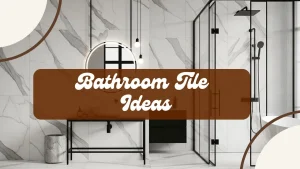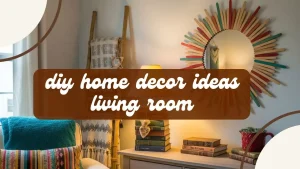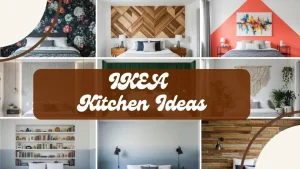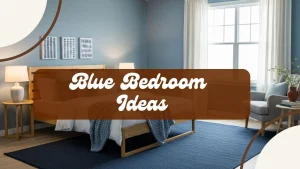Your home’s entryway serves as more than just a transition space; it is the first impression visitors receive and your daily welcome home. A well-designed entryway offers both style and function, setting the tone for your entire living space. Often, these areas become cluttered drop zones for keys, mail, and shoes. With a few thoughtful additions and smart organization, you can transform your entryway into a welcoming, efficient, and beautiful part of your home. Notably, a well-appointed entryway can boost your home’s curb appeal and potentially increase its perceived value by up to 10%.
These home entryway ideas focus on maximizing space, enhancing aesthetics, and providing practical solutions for everyday items. From small tweaks to more substantial DIY projects, these concepts help you create an entryway that is both inviting and incredibly organized. Many materials for these DIY home improvement projects are readily available at major retailers across the U.S., including those in large metropolitan areas like New York City, Chicago, and Los Angeles.
1. Define the Space with an Area Rug
Even in open-concept homes, an area rug clearly defines the entryway. This simple addition helps delineate the space, adds warmth, and offers a soft landing for shoes. Choose a durable rug that can withstand foot traffic and capture dirt. Area rugs for entryways can cost anywhere from $30 for a small, basic mat to $300+ for a larger, high-quality runner, depending on size and material. This makes it an accessible entryway decor upgrade.
How to achieve this:
- Measure Your Area: Determine the ideal size of rug that fits the width and length of your entryway without obstructing doors.
- Select Material: Opt for low-pile rugs made of natural fibers like jute or sisal for durability, or synthetic blends for easy clean.
- Consider Pattern and Color: Choose a rug with a pattern or color that complements your home’s overall decor and helps hide dirt.
- Add a Non-Slip Pad: Place a non-slip rug pad underneath to prevent slips and keep the rug in place.
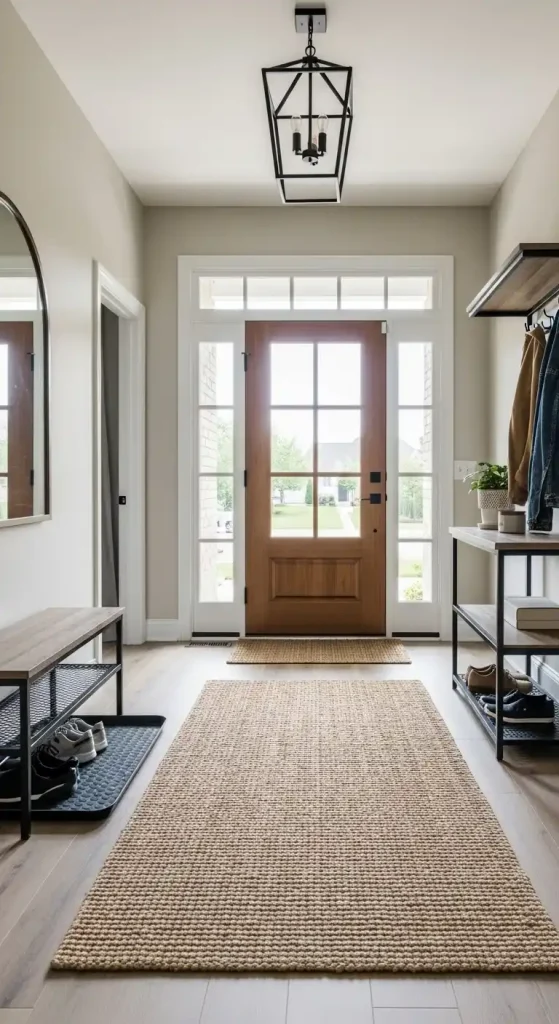
2. Install a Console Table for Keys and Mail
A slim console table is a must-have for any entryway. It provides a designated spot for keys, mail, wallets, and other small essentials you grab on your way out or drop upon arrival. Look for tables with drawers for extra hidden storage. This is a crucial piece for entryway organization. You can find console tables at major retailers like Wayfair or Overstock, with prices starting around $100 for basic models, making it an affordable addition.
How to achieve this:
- Measure Available Space: Ensure the table fits without making the entryway feel cramped. Consider depth, especially in narrow hallways common in older homes in cities like Boston or Philadelphia.
- Choose Style: Select a table style (e.g., modern, rustic, traditional) that matches your home’s aesthetic.
- Consider Functionality: Decide if you need drawers for storage or simply an open surface for display.
- Style with Intent: Place a small dish for keys, a decorative vase, or a stack of books on the tabletop.
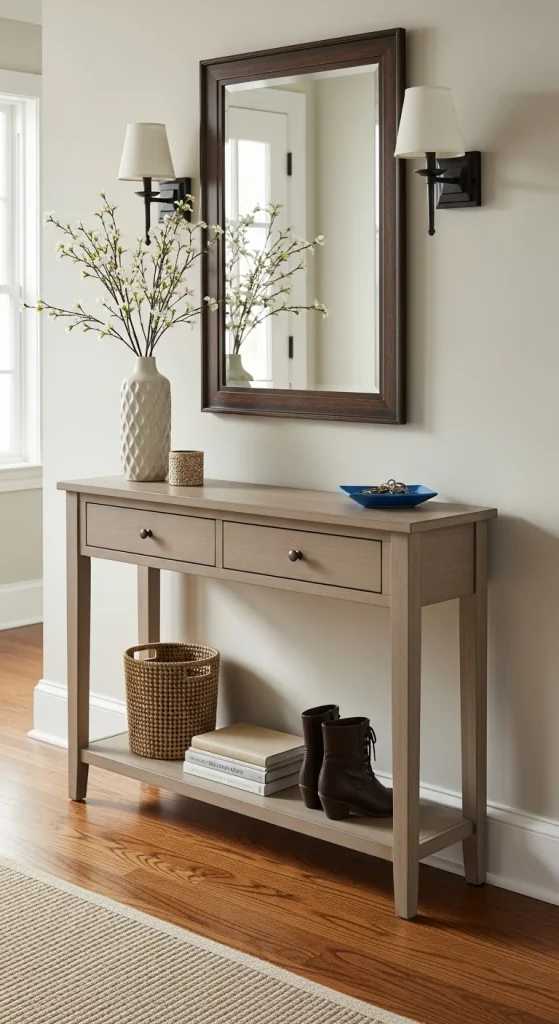
3. Add a Mirror: Function and Light
A mirror in the entryway serves multiple purposes. It offers a last-minute spot check before you leave the house and reflects light, making a small or dark entryway feel more spacious and bright. Choose a mirror that acts as a decorative statement piece. Mirrors can range from $50 for a simple frameless design to over $500 for a large, ornate piece, widely available at home decor stores and online. This is a key small space solution for entryways.
How to achieve this:
- Select Size and Shape: Determine the best size and shape for your wall space and desired visual impact.
- Choose a Frame: Pick a frame material (wood, metal, ornate) that complements your console table or other decor.
- Mount Securely: Ensure the mirror is securely mounted to the wall, especially if it is large or heavy.
- Position for Light: Place the mirror opposite a window or light source to maximize light reflection.
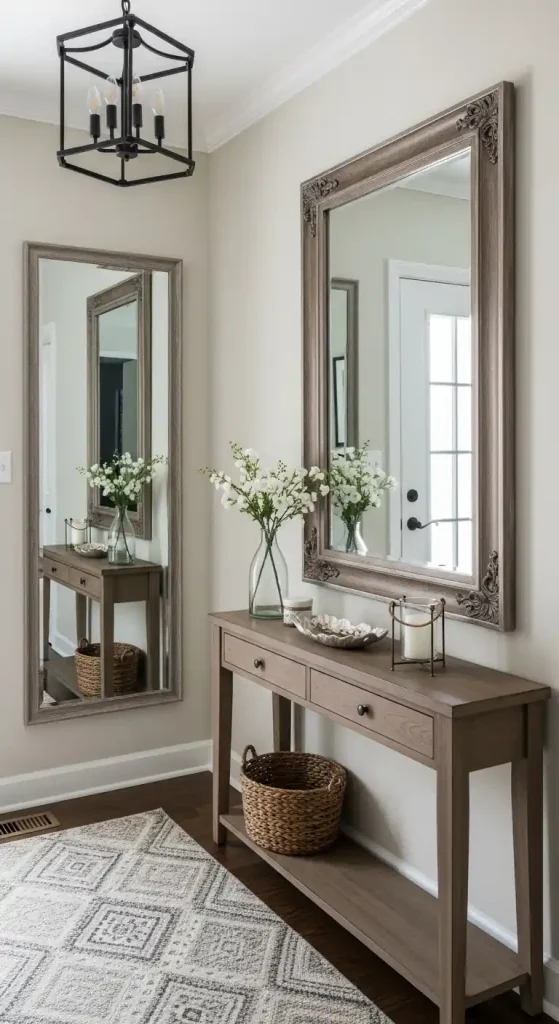
4. Provide Seating: A Spot to Put On Shoes
A bench, stool, or even a comfortable chair offers a practical spot to sit down and put on or take off shoes. This thoughtful addition enhances comfort and helps keep shoes from piling up on the floor. Look for seating with built-in storage for shoes or bags. Entryway benches with storage typically cost between $80 and $300, making them an accessible entryway furniture upgrade for many American homes.
How to achieve this:
- Assess Space: Choose seating proportionate to your entryway size. A slim bench works well in narrow spaces.
- Consider Storage: Opt for a bench with a lift-top, drawers, or cubbies underneath for shoe storage.
- Add Comfort: Place a cushion or throw pillows on the bench for added comfort and visual appeal.
- Match Decor: Ensure the seating style and material align with your home’s overall design.
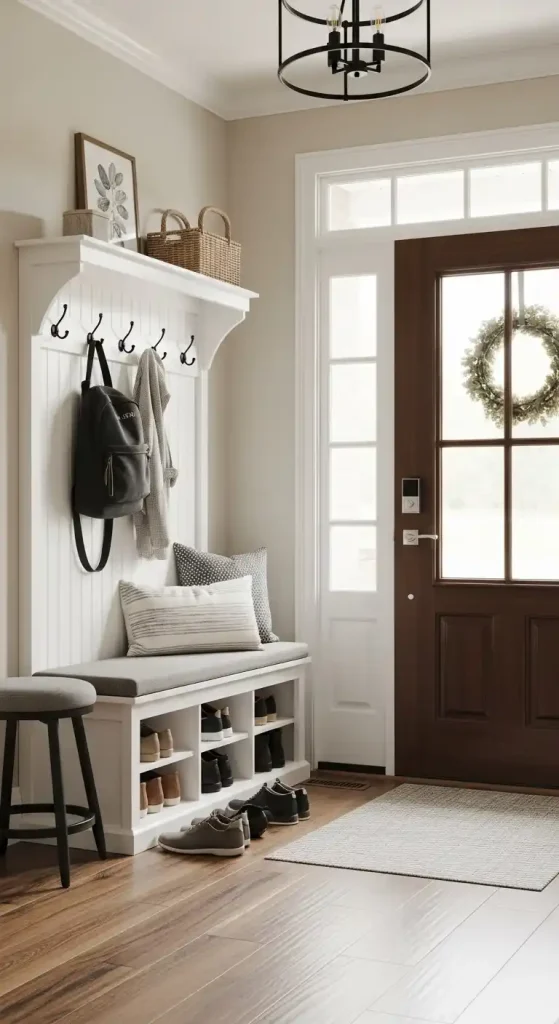
5. Install Wall Hooks or a Coat Rack: Vertical Organization
Keep coats, hats, and bags off the floor and organized with wall hooks or a freestanding coat rack. This essential home entryway idea provides vertical storage, perfect for reducing clutter, especially in busy households in areas like Phoenix or Denver where quick access is valued. Individual wall hooks generally cost $5-$15 each, while a coat rack can be $30-$150.
How to achieve this:
- Determine Needs: Count how many coats/bags you typically need to hang.
- Choose Type: Select individual wall hooks, a mounted hook rack, or a freestanding coat tree.
- Mount Securely: Install hooks or racks into wall studs for stability, as they will hold weight.
- Vary Height: Consider installing hooks at different heights for children’s coats or various bag types.
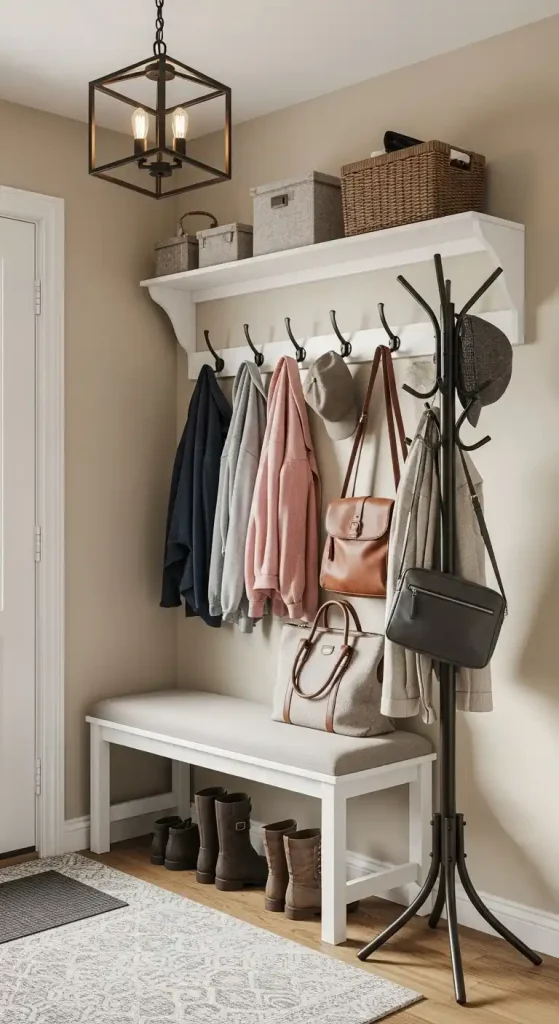
6. Create a Catch-All Bowl: Tame Small Clutter
Small items like keys, loose change, and sunglasses often create visual clutter. A dedicated catch-all bowl on your console table or shelf provides a stylish solution. This simple home entryway idea keeps small essentials contained and easy to find. This is a vital piece for entryway organization. Decorative bowls suitable for an entryway typically cost $15-$50.
How to achieve this:
- Select a Bowl: Choose a decorative bowl, tray, or dish made of ceramic, wood, metal, or glass.
- Consider Size: Ensure the bowl is large enough to hold typical items but not so large it overwhelms the table.
- Place Strategically: Position it centrally or conveniently on your console table or floating shelf.
- Empty Regularly: Make it a habit to empty and organize the contents periodically to prevent overfilling.
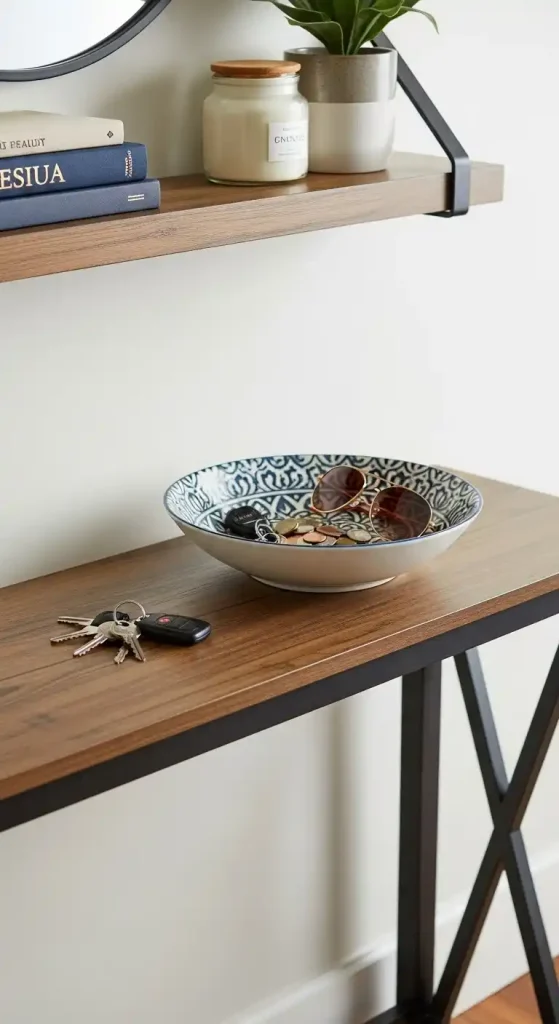
7. Add a Stylish Shoe Storage Solution: No More Piles
Shoes can quickly create a messy entryway. Implement a designated shoe storage solution to keep footwear organized and out of sight. Options range from simple shoe trays to sleek cabinets or benches with built-in cubbies. A functional shoe storage unit can range from $40 for a basic rack to $200 for a compact cabinet, providing an excellent shoe storage solution.
How to achieve this:
- Assess Shoe Volume: Determine how many pairs of shoes typically reside in your entryway.
- Choose a Solution: Select a shoe cabinet, a low bench with cubbies, a tiered shoe rack, or even decorative baskets.
- Consider Ventilation: If using a closed cabinet, ensure some ventilation to prevent odors.
- Place Conveniently: Position the storage near the door for easy access upon entry and exit.
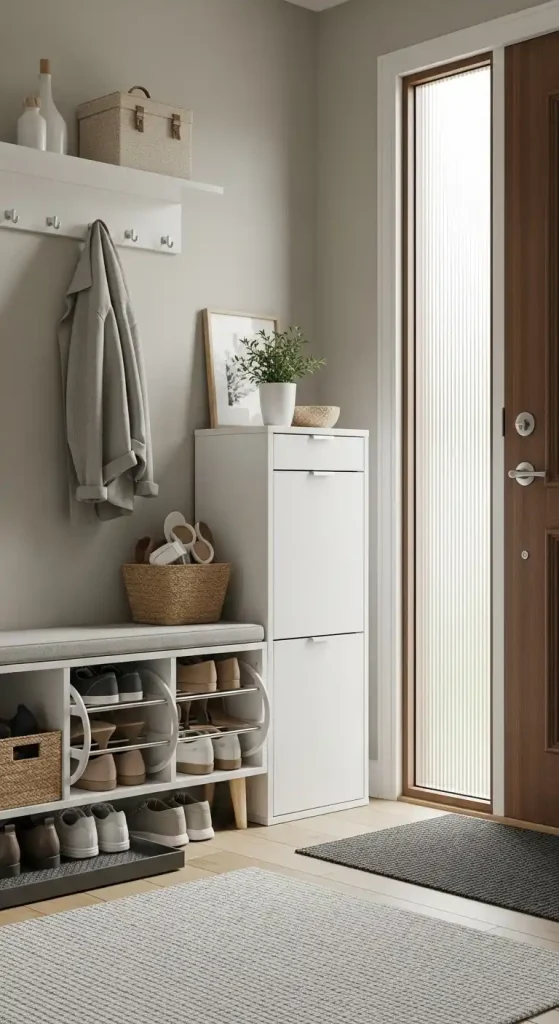
8. Introduce Greenery: A Breath of Fresh Air
Plants instantly add life, color, and a sense of freshness to any space, including your entryway. A potted plant on a console table, a hanging planter, or a taller floor plant brings natural elements indoors, making the area feel more inviting. Indoor plants suitable for an entryway can cost as little as $10-$50, with pots adding to the expense. Many plant varieties thrive indoors, even in areas with less natural light.
How to achieve this:
- Select Low-Light Plants: Choose plants that tolerate lower light conditions if your entryway lacks direct sunlight. Snake plants, ZZ plants, or Pothos are good choices.
- Choose a Stylish Pot: Select a pot or planter that complements your decor style.
- Consider Size: Pick a plant size appropriate for your available space – a small one for a table, a larger one for a corner.
- Ensure Drainage: Use a pot with drainage or a cachepot to prevent root rot.
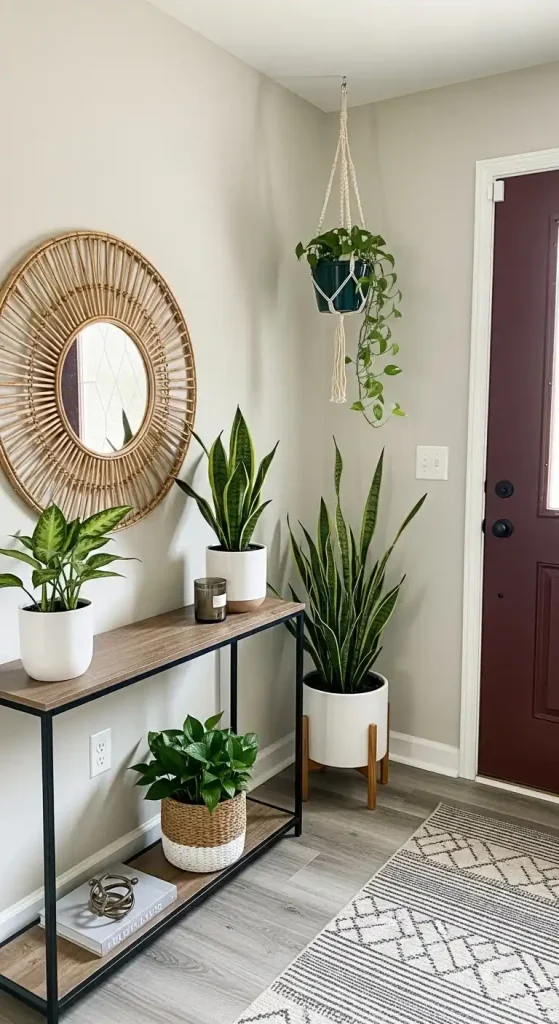
9. Install Wall Sconces or a Pendant Light: Layered Illumination
Good lighting is crucial for both function and ambiance. Beyond overhead lighting, adding wall sconces or a decorative pendant light creates layered illumination, making your entryway feel more welcoming and sophisticated. A DIY lighting fixture upgrade can cost from $50-$200 per fixture if you have existing wiring; professional installation might add $100-$300 per fixture in labor, depending on rates in areas like Seattle-Tacoma.
How to achieve this:
- Assess Existing Lighting: Determine if your entryway has sufficient overhead light.
- Choose Fixture Type: Select sconces for wall mounting or a pendant light if you have suitable ceiling height.
- Consider Style: Pick fixtures that match your home’s aesthetic (e.g., modern, farmhouse, industrial).
- Consult an Electrician (If Needed): If you lack existing wiring, consider consulting an electrician for installation, especially for hardwired fixtures.
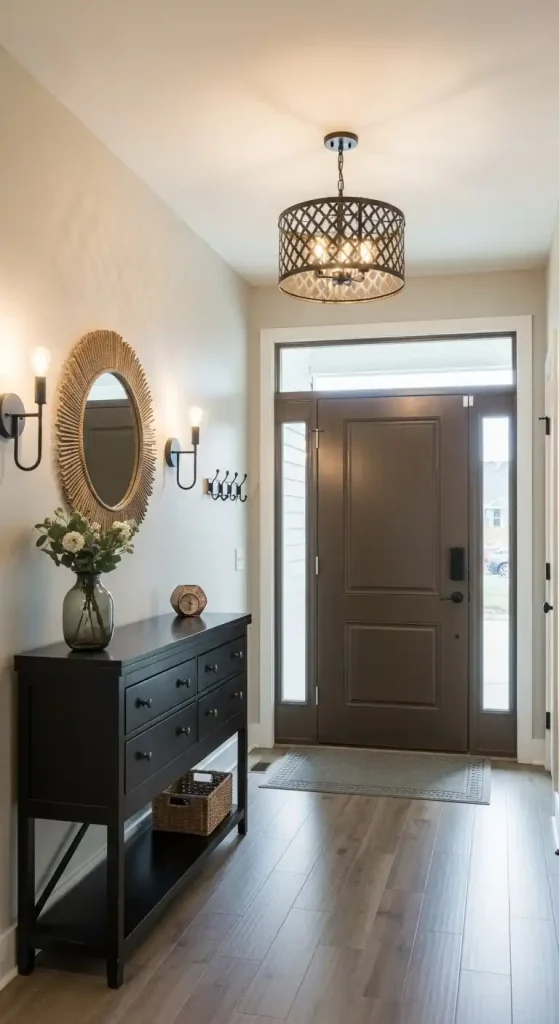
10. Create a Small Drop Zone with a Floating Shelf
For entryways without space for a console table, a floating shelf provides a minimal yet effective drop zone. This simple DIY home entryway idea gives you a place for keys, mail, or a small decorative item without taking up valuable floor space. It is an excellent small space solution. Floating shelves are quite affordable, typically ranging from $20-$70 depending on length and material.
How to achieve this:
- Measure Wall Space: Choose a wall section where a shelf will be useful but not obstruct movement.
- Select Shelf Style: Pick a floating shelf that complements your decor.
- Mount Securely: Install the shelf into wall studs for maximum stability, as it will hold weight.
- Accessorize Simply: Place a small tray for essentials or a tiny plant. Avoid clutter.
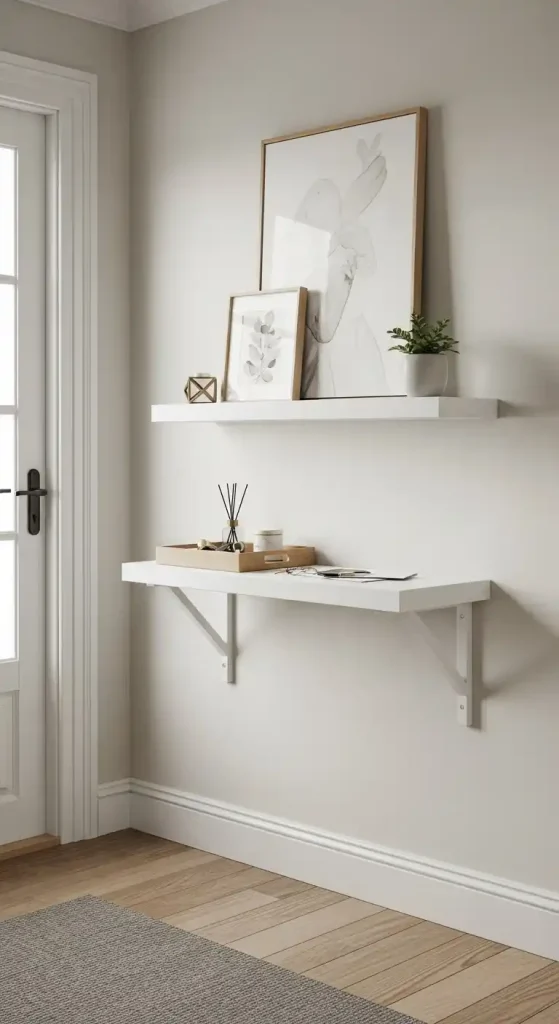
11. Add a Welcome Mat: Practicality Meets Personality
A welcome mat outside your front door serves as the very first greeting and a practical barrier against dirt. Choose a mat that reflects your personality or the style of your home. It protects your indoor flooring. This is an inexpensive entryway decor element. Welcome mats are an accessible upgrade, typically costing $15-$40.
How to achieve this:
- Select Material: Opt for durable, weather-resistant materials like coir, rubber, or synthetic blends.
- Choose Design: Pick a mat with a fun message, a classic pattern, or a simple solid color.
- Consider Size: Ensure the mat is large enough for people to wipe their feet thoroughly.
- Layer (Optional): For added style, layer a smaller welcome mat over a larger, patterned outdoor rug.
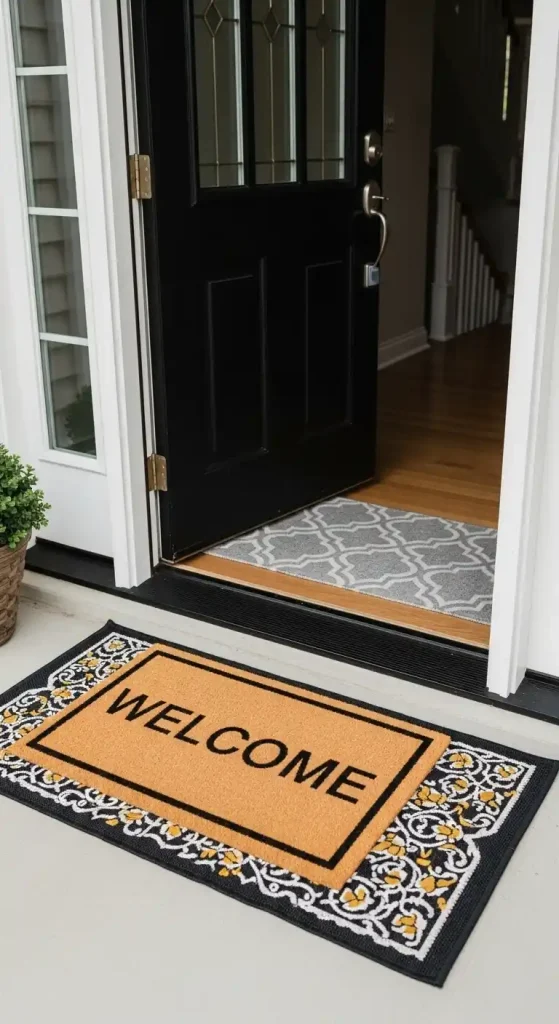
12. Utilize Wall Art or a Gallery Wall: Express Your Style
Bare walls in an entryway miss an opportunity to express your home’s personality. Add a single large piece of wall art or create a curated gallery wall. This home entryway idea instantly adds visual interest and sets the tone for your interior design. Framed prints and artwork can be found at various price points, from $20 for mass-produced pieces to hundreds for original art, or you can use personal photos for free.
How to achieve this:
- Choose a Focal Point: Decide if you want one large statement piece or a collection of smaller ones.
- Select Theme/Colors: Pick art that aligns with your home’s color scheme or a theme you wish to introduce.
- Plan Layout: For a gallery wall, arrange frames on the floor first to visualize the layout before hanging.
- Hang Securely: Use appropriate hardware to hang your art securely, especially in high-traffic areas.
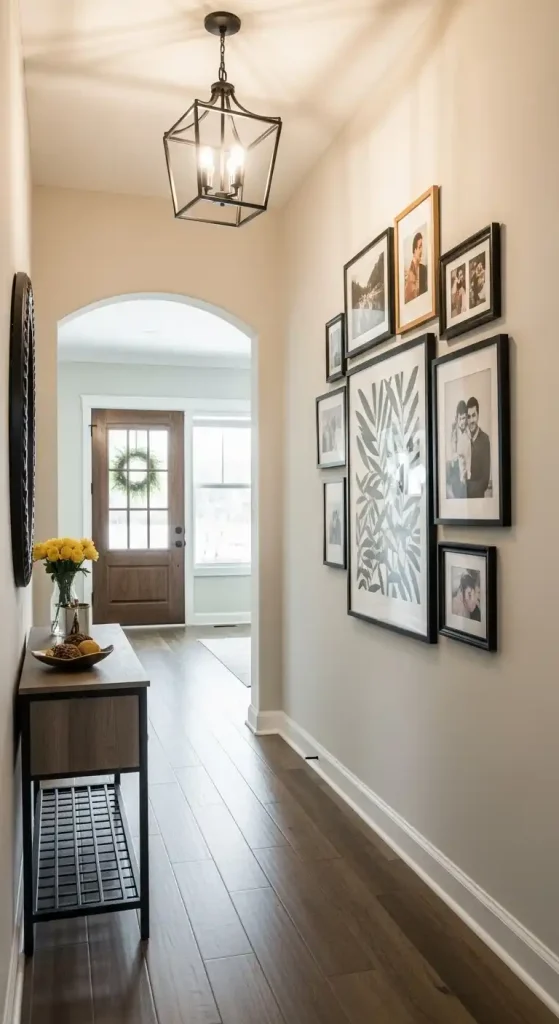
13. Install Wainscoting or Board and Batten: Add Architectural Interest
Elevate the character of your entryway by adding architectural detailing like wainscoting or board and batten. This DIY home entryway idea adds texture, protects walls from scuffs, and provides a sophisticated, finished look. It defines the space with timeless appeal. The cost for DIY wainscoting or board and batten generally ranges from $2-$7 per linear foot for materials. This can significantly enhance home aesthetics.
How to achieve this:
- Measure Walls: Determine the height and length of the walls you plan to cover.
- Select Style: Choose between traditional wainscoting panels or the more modern board and batten.
- Cut and Install Wood: Cut wood planks (for battens) or panels to size. Attach them to the wall with adhesive and nails.
- Caulk and Paint: Fill nail holes and caulk seams for a seamless look. Paint the wainscoting/batten in your desired color, often a crisp white or a complementary hue.
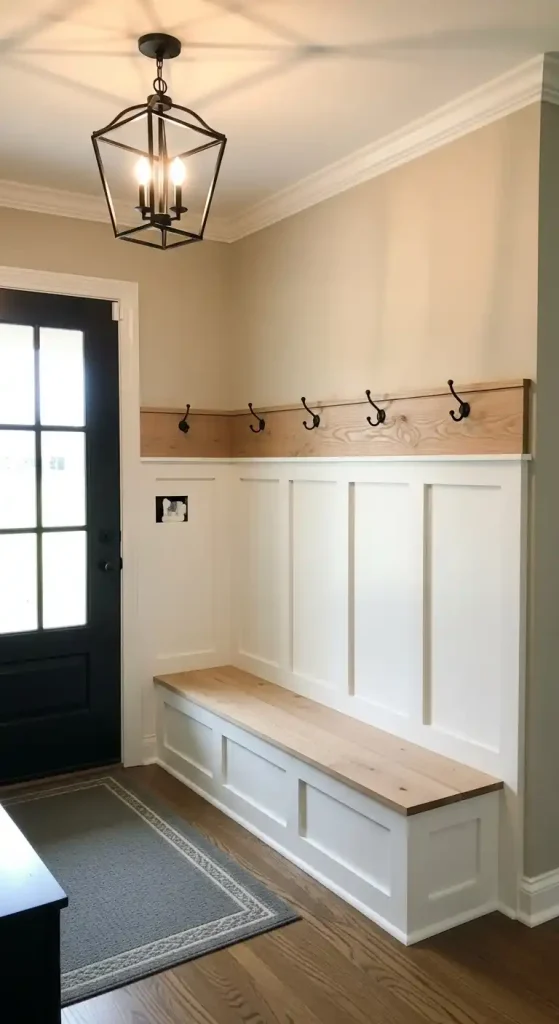
Frequently Asked Questions about Home Entryway Ideas
How much can I truly save by DIYing my entryway updates in the U.S.?
DIYing entryway updates can lead to significant cost savings, primarily by eliminating labor expenses. For a typical entryway update, labor can account for 30% to 50% of the total project budget. For instance, installing a coat rack yourself only incurs the material cost (around $30-$150), whereas professional installation could add another $50-$100 in labor. Your savings depend heavily on the project’s complexity and your local labor rates, which can vary greatly, for example, between Denver and a smaller town.
What is the most impactful home entryway upgrade for home resale value?
Adding architectural interest through wainscoting or board and batten, and ensuring excellent lighting, often provides the most significant boost to home resale value. These features offer a high-end, custom look that appeals to buyers. A welcoming, well-organized entryway creates a strong first impression, which can significantly influence a buyer’s overall perception of the home, potentially making it stand out in competitive markets like San Francisco-Oakland-San Jose.
Where can I find reliable materials and inspiration for my DIY entryway projects in the U.S.?
You can find a vast array of materials at nationwide retailers like The Home Depot, Lowe’s, and Menards, which offer everything from paint and hardware to lumber and lighting fixtures. For unique decorative items, explore stores like Target, At Home, or local boutiques. Online, sites like Wayfair, Amazon, Etsy, and specialty shops offer endless options. For inspiration and how-to guides, websites such as Pinterest, YouTube, and home decor blogs provide countless ideas and step-by-step instructions for every DIY skill level.
Conclusion
Your entryway holds immense potential to be both a functional workhorse and a beautiful introduction to your home. By implementing these 13 home entryway ideas, you can transform this often-overlooked space into an organized, welcoming, and stylish area. Each DIY project, whether small or large, contributes to creating a harmonious flow from the moment you step inside. Choose the ideas that best fit your skills and needs, and enjoy the satisfaction of a perfectly designed welcome.

